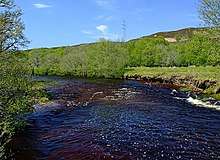Strath
A strath is a large valley, typically a river valley that is wide and shallow (as opposed to a glen, which is typically narrower and deep).[1]

Word and etymology
An anglicisation of the Gaelic word srath, it is one of many that have been absorbed into the English and Scots languages. It is commonly used in rural Scotland to describe a wide valley, even by non-Gaelic speakers.
In Scottish place-names, Strath- is of Gaelic and Brittonic origin.[2] Strath- names have the genesis with Gaelic srath meaning "broad-valley", as well as with the Cumbric and Pictish cognates (c.f. Welsh ystrad).[2]
Gaelic srath is derived from Old Irish srath, recorded as having meant "grassland".[3] The modern Scottish Gaelic sense of "broad-valley", paralleling the meaning of Brittonic cognates, developed from substrate influence from Pictish.[3]
Toponymy
It occurs in numerous place names within Scotland including Strathspey and Strathclyde. Internationally, many places with Scottish heritage also use the prefix, including Strath-Taieri in New Zealand; Strathalbyn in South Australia, Strathfield, a suburb of Sydney, Australia; Strathewen, Victoria, Australia; Strathpine, a suburb of Brisbane, Australia; and various places in Canada: Strathmore, Alberta; Strathcona; Strathroy, Ontario; and Strathburn, Ontario.
It also occurs in the names of five Peninsular and Oriental Steam Navigation Company liners, four of which, the Strathaird, the Strathnaver, the Stratheden and the Strathmore, carried thousands of migrants to Australia between the 1950s and the 1960s. The ships acted as troop carriers during the Second World War and the fifth ship, the Strathallan, sank in the Mediterranean in 1942 taking troops to the landings in North Africa.[4]
The word is related to Old Welsh Ystrad, as in Ystrad Clud, the Old Welsh name for the Kingdom of Strathclyde.
In Keith there is a distillery producing the Strathisla whisky. It is a single malt whisky that is also an ingredient to the blend Chivas Regal.
In geology
In geology, a strath is a bedrock surface within a river valley that marks a former base level of erosion by the river.[5]
See also
- Annandale, Dumfries and Galloway
- dale (place name element)
References
- T. A. Gibson (1835). Etymological Geography: Being a Classified List of Terms of Most Frequent Occurrence, Entering, as Prefixes or Postfixes, into the Composition of Geographical Names. Oliver & Boyd. p. 23. Retrieved 21 March 2013.
- James, Alan G. "The Brittonic Language in the Old North - A Guide to the Place-Name Evidence" (PDF). Scottish Place Name Society. Retrieved 14 June 2020.
- Hall, Mark A; Driscoll, Stephen T; Geddess, Jane (11 November 2010). Pictish Progress: New Studies on Northern Britain in the Early Middle Ages. Brill. ISBN 9789004188013. Retrieved 30 June 2019.
- "The Strathallan Story". Archived from the original on 2007-10-09. Retrieved 2007-12-20.
- Thornbury, William D. (1969). Principles of geomorphology (2d ed.). New Delhi: CBS Publishers. p. 111. ISBN 8123908113.